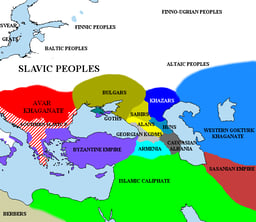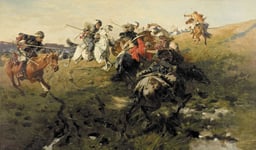Pontic–Caspian steppe
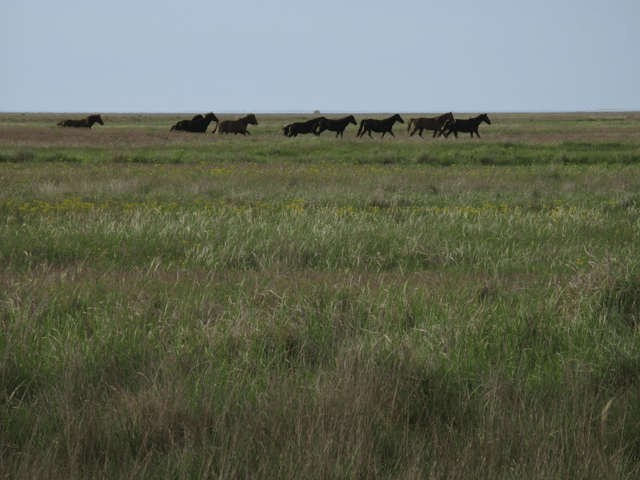
Pontic–Caspian steppe

| Pontic–Caspian steppe | |
|---|---|
 The steppe extends roughly from the Dniepr River to the Ural River | |
| Ecology | |
| Realm | Palearctic |
| Biome | Temperate grasslands, savannas, and shrublands |
| Geography | |
| Area | 994,000 km2(384,000 sq mi) |
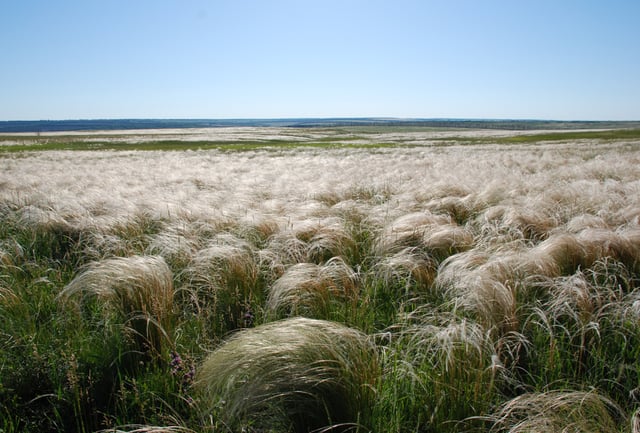
Streltsovskaya Steppe, a preserved area in Milove Raion in Luhansk Oblast, Ukraine. The steppe is often dominated by plumes of Stipa in early summer.
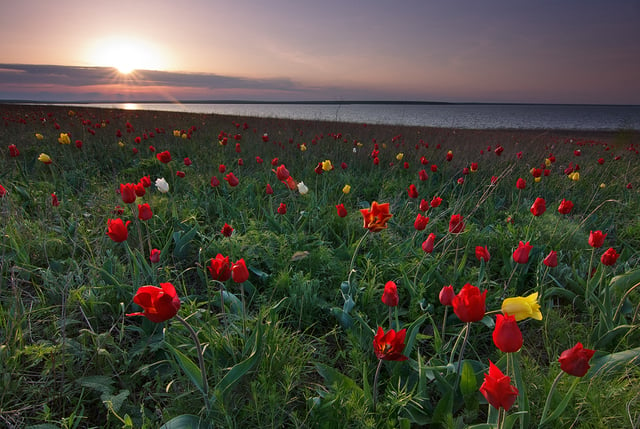
Tulipa suaveolens is one of the most typical spring flowers of the Pontic-Caspian steppe.
The Pontic–Caspian steppe, Pontic steppe, or Ukrainian steppe is the vast steppeland stretching from the northern shores of the Black Sea (called Euxeinos Pontos [Εὔξεινος Πόντος] in antiquity) as far east as the Caspian Sea, from Dobruja in the northeastern corner of Bulgaria and southeastern Romania, through Moldova and eastern Ukraine across Russian Northern Caucasus, Southern and lower Volga regions to western Kazakhstan, forming part of the larger Eurasian steppe, adjacent to the Kazakh steppe to the east. It is a part of the Palearctic temperate grasslands, savannas, and shrublands ecoregion of the temperate grasslands, savannas, and shrublands biome.
The area corresponds to Cimmeria, Scythia, and Sarmatia of classical antiquity. Across several millennia the steppe was used by numerous tribes of nomadic horsemen, many of which went on to conquer lands in the settled regions of Europe and in western and southern Asia.
According to a theory, called Kurgan hypothesis in Indo-European studies, the Pontic–Caspian steppe was the homeland of the speakers of the Proto-Indo-European language, and these same speakers were the original domesticators of the horse.[2][3][4][5]
| Pontic–Caspian steppe | |
|---|---|
 The steppe extends roughly from the Dniepr River to the Ural River | |
| Ecology | |
| Realm | Palearctic |
| Biome | Temperate grasslands, savannas, and shrublands |
| Geography | |
| Area | 994,000 km2(384,000 sq mi) |
Geography and ecology
The Pontic steppe covers an area of 994,000 square kilometres (384,000 sq mi) of Europe, extending from Dobrudja in the northeastern corner of Bulgaria and southeastern Romania, across southern Moldova, Ukraine, through Russia to northwestern Kazakhstan to the Ural Mountains. The Pontic steppe is bounded by the East European forest-steppe to the north, a transitional zone of mixed grasslands and temperate broadleaf and mixed forests.
To the south, the Pontic steppe extends to the Black Sea, except the Crimean and western Caucasus mountains' border with the sea, where the Crimean Submediterranean forest complex defines the southern edge of the steppes. The steppe extends to the western shore of the Caspian Sea in the Dagestan region of Russia, but the drier Caspian lowland desert lies between the Pontic steppe and the northwestern and northern shores of the Caspian. The Kazakh Steppe bounds the Pontic steppe to the east.
The Ponto-Caspian seas are the remains of the Turgai Sea, an extension of the Paratethys which extended south and east of the Urals and covering much of today's West Siberian Plain in the Mesozoic and Cenozoic.
Prehistoric cultures
Linear Pottery culture 5500–4500 BC
Cucuteni-Trypillian culture 5300–2600 BC
Khvalynsk culture 5000-3500 BC
Sredny Stog culture 4500–3500 BC
Yamna/Kurgan culture 3500–2300 BC
Catacomb culture 3000–2200 BC
Srubna culture 1600–1200 BC
Novocherkassk culture 900–650 BC
Historical peoples and nations
Cimmerians 12th–7th centuries BC
Dacians 11th century BC – 3rd century AD
Scythians 8th–4th centuries BC
Sarmatians 5th century BC – 5th century AD
Ostrogoths 3rd–6th centuries
Huns and Avars 4th–8th centuries
Bulgars (Onogurs) 4th–7th century[6]
Alans 5th–11th centuries
Eurasian Avars 6th–8th centuries
Göktürks 6th–8th centuries
Sabirs 6th–8th centuries
Khazars 6th–11th centuries
Pechenegs 8th–11th centuries
Kipchaks and Cumans 11th–13th centuries
Mongol Golden Horde 13th–15th centuries
Cossacks, Kalmyks, Crimean Khanate, Volga Tatars, Nogais and other Turkic states and tribes 15th–18th centuries
Pontic Greeks and Caucasus Greeks 15th–19th centuries
Russian Empire 18th–20th centuries
Soviet Union 20th century
See also
List of ecoregions in Europe
Black Sea-Caspian Steppe
Crimean–Nogai raids into East Slavic lands
Eurasian Steppe
Haplogroup R1a1 (Y-DNA)
Haplogroup R1b1 (Y-DNA)
Kurgan hypothesis
Late Glacial Maximum
Steppe Route
Tarim mummies
Temperate grasslands, savannas, and shrublands
Ukrainian stone stela
